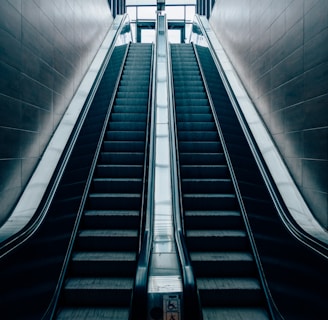Escalator Maintenance Best Practices: A Technician's Toolkit
Escalator Maintenance Best Practices: A Technician's Toolkit
ESCALATOR
3 min read


Why is escalator maintenance important?
Escalator maintenance is a critical aspect of ensuring the safety and efficient operation of these vertical transportation systems. As an elevator and escalator engineer, understanding and implementing best practices is essential. The elevator company plans the escalator maintenance schedule it helps the technician to cover every part of an escalator and ensure regular service of escalators. Here's an in-depth guide, covering key aspects of escalator maintenance:-
1. Regular Inspection Protocols:-
Escalator maintenance's best practice first step is to plan regular inspections for eg. Monthly, quarterly, half-yearly, and yearly PPM plans.
Conduct thorough visual inspections to identify any signs of wear, damage, or misalignment of steps, combs, step demarcation line, direction indicator, handrail belt, decking joint, skirt panel, floor plate, skirt brush, and announcement systems.
Utilize diagnostic tools to assess the condition of critical components such as handrails belt, steps, and drive systems.
Check controller condition note fault history up to the 10 faults with the help of the service tool. Implement a systematic approach to detect and address potential issues before they escalate.
2. Lubrication Techniques:-
Lubrication of escalator parts is very important it helps reduce wear and tear increases the escalator life span and provides smooth operation.
Employ high-quality lubricants specifically designed for escalator components.
Establish a comprehensive lubrication schedule based on manufacturer recommendations.
Pay special attention to motor gearbox oil, drive chains, handrail drive chains, and step chains to minimize friction and extend the component life span.
check automatic lubrication system working if available in an escalator.
3. Tensioning and Alignment:-
Tensioning and alignment of escalator steps, chains, combs, and handrail belts are important work that requires a proper technician. Always prefer documents before adjusting to the tensions of spring and adjusting the gap between two parts.
Regularly check and adjust tension in drive chains to ensure proper engagement and prevent excessive wear.
Check the step chain tension spring length and set it according to the document.
Align steps and handrails to minimize strain on the system and ensure smooth operation.
Adjustment of braking system check break distance etc.
Utilize laser alignment tools for precise adjustments, enhancing overall system efficiency.
4. Electrical System Maintenance:-
The escalator controller is the heart of the escalator. The escalator control system includes MCCB, MCB, RCCB, fuse, contactor, relay, sensor, wiring connection, drive, and control PCBs for the safe and smooth working of an escalator.
Conduct routine inspections of electrical components, including control panels, sensors, and safety devices. Clean the sensor, and check whether the wiring connection is properly tight or not.
Test and calibrate safety features such as emergency stop buttons, comb impact devices, skirt switches, handrail entry boot switches, platform switches, handrail speed sensors, key switches, break working condition, and sensors.
Stay updated on the latest advancements in escalator control systems for optimal performance.
5. Emergency Preparedness:-
Emergency breakdowns of escalators are inevitable we can only reduce them by proper maintenance and service of the escalator so we need to always be ready for future breakdowns and prepare in advance for it.
Develop a comprehensive emergency response plan for escalator breakdowns.
Train maintenance personnel in swift troubleshooting techniques to minimize downtime.
Keep essential spare parts on hand to facilitate quick repairs and replacements.
6. Customer Communication:-
Customer communication is a key part of the escalator's safe and smooth operation because technicians can't be available to check every escalator 24×7 so customers can help the technician by providing proper feedback in unusual conditions.
Establish clear communication channels with building management and stakeholders.
Provide regular updates on maintenance schedules and any upcoming system enhancements.
Encourage reporting of unusual sounds, vibrations, or other issues from users for proactive problem-solving.
7. Modernization Strategies:-
According to time like every industry escalators also evolve with time compare today's escalator model or parts back 20 years you can check the difference.
Stay informed about advancements in escalator technology and consider modernization options.
modernization helps better safety features and energy efficiency of escalators.
Evaluate the feasibility of upgrading components to improve energy efficiency and comply with current safety standards.
Collaborate with manufacturers to explore retrofitting possibilities for aging escalator systems.
8. Documentation and Record-Keeping:-
Documentation and record-keeping help us to compare data and fault history of the escalator, visits, and work done by technicians on that escalator. By checking the record document any new technician can understand the condition and problem of that escalator.
Maintain detailed records of maintenance activities, inspections, and repairs.
Document any deviations from standard procedures and the corresponding corrective actions taken.
Document every visit on an escalator, the time date, and name of the technician, and what work they did on that visit.
Utilize a computerized maintenance management system (CMMS) for efficient data organization and retrieval.
In conclusion, a comprehensive approach to escalator maintenance involves a combination of regular inspections, detailed attention to components, and proactive communication. By implementing these best practices, elevator and escalator technicians contribute significantly to the safety and longevity of these vital transportation systems.

